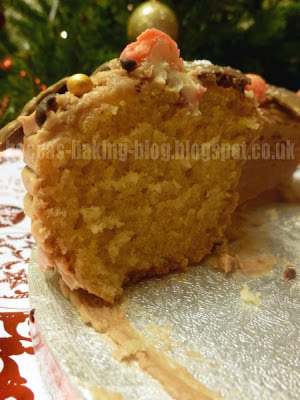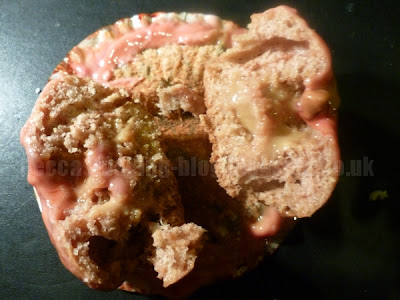Now this was a cake I've had in mind for months. This year is the turn of the fiancé's Mum to host the Christmas dinner for her side of the family. I got to make dessert and I knew I wanted to bake a cake made to look like a wreath. I even got a special ring mould and everything!
So it's a vanilla sponge ring covered in chocolate orange buttercream made to look like bark, which is then decorated with dark chocolate branches, milk chocolate holly leaves and white chocolate truffle berries, tinted with gold lustre powder and dusted with icing sugar.
I would have liked to make my chocolate leaves by painting chocolate onto actual (or wax) leaves but I couldn't find any holly. So I had to resort to piping the chocolate shapes instead, which meant they were a bit thicker and less refined than I would have liked but they still looked pretty good.
The truffle berries gave me the most trouble because they just did not want to set and I was already running over the time I had said we would head down to the house. Ideally they would have been perfectly round but due to the lack of time and the fact they ended up fused to the wire rack they were setting on, I had the slice them off so the bases are flat. They still tasted yummy though. The buttercream also gave me some difficulty too since I ran out of orange extract making cupcakes for work and couldn't find any in the local supermarket. So I had to use the juice of an orange instead, which made the buttercream runnier and thus I had to add more icing sugar to get the right consistency. A bit of trial and error, which was slightly annoying but I got there in the end. I'll be putting extract in the recipe write-up though.
It went down very well with everyone who ate it. They said it was light and fluffy and the buttercream was delicious, which isn't surprising since it is one of my most popular flavours.
Cake:
- 225g/8oz butter
- 225g/8oz caster sugar
- 2 tsp vanilla extract
- 4 large eggs
- 225g/8oz self-raising flour
- Preheat the oven to 180°C/350°F/Gas Mark 4 and grease a 24cm ring mould with butter.
- In a bowl, beat together the butter, sugar and vanilla extract until it is smooth and creamy.
- Add the eggs one at a time and beat well after each addition.
- Sift in the flour and fold in until fully incorporated.
- Spoon the mixture into the ring mould, trying to distribute it evenly. Run your spoon round the top to smooth it out.
- Bake for 30-40 minutes, until the sponge is springy to the touch and a skewer inserted through it comes out clean.
- Leave in the mould to cool for about 15 minutes before transferring to a wire rack to finish.
- 140g/5oz butter
- 280g/10oz icing sugar
- 100g/3.5oz milk chocolate
- 2 tsp orange extract
- Put the milk chocolate in a glass bowl and set over a pan of simmering water to melt. Don't let the bowl touch the water.
- Beat the butter, icing sugar and orange extract together in a bowl until smooth a creamy.
- Add the melted chocolate to the buttercream and mix in until well incorporated. You're aiming for a soft but spreadable consistency so if it's a bit runny, add more icing sugar.
- Place the cake on a cake board or plate.
- With a rubber spatula or a palette knife, spread a thin layer of buttercream over the cake to form a crumb coat.
- Now coat the cake in a thicker layer, making sure there are no gaps. Wipe up any buttercream that falls on the board/plate with a cloth so you have a clean finish.
- Use a fork to draw lines in the buttercream to resemble tree bark.
Decoration:
- 85g/3oz white chocolate
- 15ml/0.5fl.oz whipping cream
- 25g/1oz dark chocolate
- 75g/2.5oz milk chocolate
- Red blossom tint
- Gold lustre dust
- Icing sugar for dusting
- Gold edible pearls
- Put the cream and 50g/2oz of the white chocolate in a glass bowl over a a pan of simmering water.
- When the chocolate has melted, whisk the ganache together until it is smooth. Set to one side to cool. It needs to get a pipeable consistency so if it's still really runny after cooling, put in the fridge to firm up. This may take an hour or so.
- Next, cover a tray with a a sheet of greaseproof paper.
- Melt the milk chocolate then put into a piping bag fitted with a small round nozzle and pipe holly leaves onto the prepared tray. Start by drawing an outline and then fill it in. Make as many as you want. It's always good to have spares in case of breakages or for future decorations. Leave to set.
- Melt the dark chocolate then put in a piping bag fitted with a small round nozzle.
- Draw branches with the chocolate over the top of the cake (so lines with more lines branching off them). Leave to set.
- Prepare another tray with greaseproof paper.
- Once the ganache has firmed up, spoon into a piping bag fitted with a large round nozzle.
- Pipe small blobs of ganache onto the tray. Doesn't matter if you don't get perfect spheres, you can fix that later.
- Place the ganache back in the fridge to set. If you want it to set faster you can put it in the freezer.
- Meanwhile, melt the remaining 35g/1oz white chocolate and stir in the red blossom tint.
- Once the leaves have set, take the gold lustre dust and brush over the surface of the leaves with a pastry brush.
- Place the leaves on the cake, pressing gently into the buttercream so they stay in place.
- If the ganache is set, remove from the fridge.
- One at a time, quickly roll a blob of ganache between your hands to make a ball and then drop into the melted white chocolate.
- Quickly coat the ball and then remove and place back on the tray.
- When all the balls are coated, leave them to set.
- Once set, remove from the tray. If they get stuck, use a knife to slice them away from it.
- Place the berries on the cake, matching them up with the base of the leaves. Dust the berries with the gold lustre dust.
- Place the gold pearls around the buttercream.
- Finish the cake by dusting it with icing sugar.
































